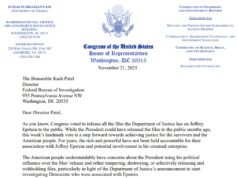
In June of 1969, the Cuyahoga River, just south of Cleveland, Ohio, caught fire again. Once considered one of the most industry-polluted rivers in the United States, its waters ran rampant with flammable oils and chemicals. Over thirteen fires were reported in the year 1868, continuing on through the mid 1950’s, with one particularly bad fire in 1952 that claimed over $1.3 million in damages. In 1969, however, the fire caught more attention: Time Magazine published an article, and the Cuyahoga River plunged into the spotlight of American politics. That spring at the behest of American outcry, Congress introduced legislation to resolve the issue of land pollution. By January 1st, 1970, The National Environmental Protection Act (NEPA), the precursor to the EPA, was signed into law, with the Clean Water Act of 1972 as one of its first pieces of legislation. The CWA insisted that all rivers in the U.S. were safe enough to allow large amounts of both swimmers and fish by 1983.
Fifteen years later, just outside of Youngstown, Ohio, David Sponsler, an assembly-line worker at General Motors, took his four year old daughter, Katie, to catch her first fish in the Cuyahoga River. David and Mary Beth Sponsler had seven children, and it became a rite of passage that as each child came of age, they would catch their first fish in the river, learn how to clean it, and build a fire on-site to cook it; an introduction to independence, natural sustenance, and the distinct awareness that we are all connected. This idea of symbiosis, along with a personal pride in the legacy of the Cuyahoga River, became a rallying cry for Katie Sponsler, who now lives in Colonial Heights, Virginia, where she eyes the James River to reinstate this rite of passage to her own son, who has just turned two.
The James has gone through its own sordid history of toxicity and pollution. For local Virginians it is hard to forget the Kepone disaster. Kepone, the toxic, non-biodegradable insecticide created by Allied Chemical Corporation in Hopewell, was illegally dumped into the James River between 1966 and 1975. At the height of its output, the company produced between 3,000-6,000 pounds of Kepone per day. The plant eventually closed when its employees began falling victim to intense neurological disorders (these same employees, along with fishermen and residents, eventually received over $200 million in damages). Known to cause reproductive disorders, liver, skin, and vision disorders, and a wide-range of neurological issues, the Kepone scandal became the worst environmental disaster in the Commonwealth’s history. In December of 1975, Governor Mills E Godwin ordered a ban on all fishing in the James River, decimating the local fishing industry. Ten years later the chemical remained embedded on the bottom of the James; certain fish were still too contaminated to consume. The millions of dollars in fines received from Allied Chemical Corporation’s Life Science plant for cleanup were long gone, and authorities warned that a hurricane or other natural disaster could agitate the sediment back into the current of the river.

The James has not improved all that much. In 2010, environmental reports stated that more toxic chemicals were dumped in Virginia’s waterways than any other state in the country; at least 18 million pounds of toxic chemicals were released, with over 1.1 million dumped into the James River alone. These toxins include chemicals that range in effects from cancer to birth defects and reduced fertility, along with arsenic, mercury, and benzene. In 2011, the Chesapeake Bay Program gave the river a “C” in a health grade report, which many scientists claimed had to do with the ambiguity resulting from two Supreme Court cases about the Clean Water Act, in 2001 and 2006. These lawsuits narrowed guidelines within the act that effectively removed protections from streams and wetlands.
When the CWA was first passed, it logically included protection for all bodies of water in the country based on the obvious reality that all bodies of water are interconnected in some way. The lack of clarity that resulted from the Supreme Court cases, in which Justice Kennedy and Justice Scalia had differing views on the extent of land protected, led to large swaths of unprotected streams, wetlands, and headwaters. Rapanos v. U.S. in 2006, where Justice Kennedy argued for more wetlands to be protected and Justice Scalia argued for less, resulted in such obscure legal limbo that all legal disputes since have needed to be resolved through courts on a case-by-case basis. In order to close this loophole that allowed industries and farmers to dump into unprotected waters, or effectively destroy them, without the need of a permit, a new safeguard was proposed in 2014 by the EPA and the US Army Corps of Engineers. This legislation was backed by vigorous scientific review (signed by more than 1,200 scientists), as well as robust support from citizens, fishermen, local and state government employees, and environmental groups.
In May of 2015, the Obama Administration added federal protection for streams and headwaters, which was intended to close the loophole that had left these waters vulnerable for a decade. By clarifying and restoring protections to almost all of the nation’s fresh waters, it ensured safe drinking water for 117 million Americans. Obama’s protection was never enacted. Almost immediately, the Sixth Circuit Court put a temporary hold on the new rule, once again putting waterways in legal peril. Shortly before leaving office, in late December of 2016, President Obama signed the Stream Protection Rule. By his second week in office, President Trump had signed a measure blocking it. Citing job crushing EPA overreach, the take down of the Environmental Protection Agency has been a top priority of Republicans in Congress.
The Stream Protection Rule triggered major blowback from both farmers and industry groups, who claimed it would “give bureaucrats carte blanche to swoop in and penalize landowners,” and conservatives saw it as the perfect example of EPA overreach. While farmers and ranchers voiced their opposition, citing that the EPA has vastly expanded beyond its approved limits, Jon Devine, a lawyer for Natural Resources Defense Council, strongly disagrees. He pointed out that the Clean Water Act had a history of going easy on agricultural regulation and that this rule did not really change that exemption. One recent study found that the EPA’s jurisdiction over farms actually shrank under the new rules. The EPA has always been explicit in not targeting farmers. The Stream Protection Rule aimed to restrict coal mines from dumping debris into nearby streams. President Trump stated that ending the rule would result in massive job savings. Congressional researchers found that only approximately 124 jobs would be lost over the rule, while in trade off, the rule would be an effective policy protecting the drinking water of over 100 million Americans.
Recently sworn in as the new head administrator of the EPA under President Trump, Scott Pruitt has vowed to not only repeal these laws, but effectively dismantle the EPA from within. As the Attorney General for the state of Oklahoma, Scott Pruitt sued the EPA fourteen times while fighting on behalf of the energy companies. Emails that were released just days after he was voted in by the Republican-controlled congress, showed his incredible ties to environmentally-hazardous energy industries. At CPAC, Pruitt promised to roll back the regulatory state, and he has a five-point plan to deconstruct the EPA, which include deep budget cuts, relaxing enforcement against illegal pollution (like that of Kepone), the rollback of pollution standards, reformation of the “scientific process” (climate change denial), and to abandon the legal defense of EPA rules against suits by polluters.
Myron Ebell, head of Trump’s EPA transition team, stated that the Trump Administration’s objective is to permanently cripple the agency’s capacity to bounce back under future presidents. On February 3rd, Representative Matt Gaetz (R,FL) introduced H.R. 861, a bill to terminate the EPA. Last Thursday, Scott Pruitt’s EPA announced that it will halt inquiries into oil and gas industry emissions of methane, and they have proposed plans to slash the agency of 1/5th of its employees, which would effectively eliminate key programs. On that chopping block are major cuts to air and water programs, and would mean that the massive Chesapeake Bay clean-up project would receive only $5 million in the next fiscal year, as compared to the current amount of $73 million.
On a more local front, the environment appears to have slightly more bipartisan support. State Senator Amanda Chase (R, Colonial Heights) co-sponsored a bill with Scott Surovell (D, Fairfax) which calls Dominion Energy, Inc to identify and resolve pollution caused by its facilities. The goal was to get Dominion to prevent coal ash from impacting environmentally sensitive areas. Coal ash has come to the spotlight in Chesterfield County recently as claims have come forward that it is leaking from unlined ponds surrounding Dominion power plants and polluting the Dutch Gap Conservation Area. Coal ash is a waste by-product of burning coal to generate electricity, and contains heavy metals such as arsenic, lead, and chromium. In the end, over ten Republican state senators voted for Surovell’s bill, included in the ten are all three senators from Chesterfield: Chase, Sturtevant (R), and Dance (D).
The bill was then sent to the House and moved into a subcommittee. The subcommittee, however, removed a very important piece of the bill that would require that state officials have a chance to review the findings of an investigation before the DSQ would be able to issue Dominion’s solid waste permits. This version of the bill passed the House. In a last ditch attempt to save the original bill, Senator Chase reached out to Governor McAuliffe (D), seeking his help to add an amendment that would give one year to examine the Dutch Gap Conservation Area for coal ash before Dominion can receive its permits. Governor McAuliffe has until next month, when the General Assembly reconvenes, to consider Governor’s amendments, and even then, it would still need to be approved by a simple majority in both houses.

Our representative in Washington, Dave Brat (R), Congressman for District 7 (which includes most of Chesterfield County), however, does not share this bipartisan goal to protect our environment. Working in opposition to these efforts, he voted to pass a 2015 bill in which coal ash is designated as non-hazardous. Brat, who gained the instant spotlight with his historic upset of Eric Cantor back in 2014, only has a 2-year history in the House, but in those two years, he has co-sponsored the bill to repeal the Stream Protection Rule and he co-sponsored two bills, one in 2015 and one in 2017, which amends the Clean Air Act to exclude carbon dioxide, water vapor, methane, nitrous oxide, hydrofluorocarbons, perfluocarbons, and sulfur hexafluoride pollution from the scope of that act. He has also co-sponsored a bill that “repeals the authority of the EPA to deny or restrict the use of any area as a disposal site for dredged or fill material when the discharge of those materials would have an unacceptable adverse effect on municipal water supplies, shellfish beds and fishery areas, wildlife, or recreational areas.” Last Friday, H.R. 1314 was introduced that Brat has also co-signed, which repeals the renewable fuel program of the EPA.
Brat believes that the key to a safe and clean environment lies solely in the unfettered free market economy and economic prosperity. The EPA, then, would be unnecessary as, once all the regulatory overreach is curbed, the U.S. economy will flourish, creating a more wealthy society. At a recent town hall meeting in Blackstone, in response to questions of clean drinking water, he stated that “rich people like clean water.” Though not received well by his constituents, the idea is that as we all become richer, we will prioritize the environment because wealthy people value these things – clean air and clean water. American ingenuity then can create the naturally cleaner environment that we crave without federal interference. When asked about global warming, his response varies from tongue-and-cheek retorts to the repetition of a well-worn mythical story used to undermine trust in climate scientists while also dancing with denial. The idea that the environment will naturally figure itself out is routinely challenged, however, as cases like Flint, Michigan, or contaminated drinking water due to fracking, come to light. It also distinctly ignores the poorest countries, as they suffer the most from the lack of regulation in industrialized nations. While local lawmakers, with bipartisan support, have come forward seeking to protect Virginia’s waterways, our lawmaker in Washington has distinctly sabotaged that effort.

Back at the James River, Katie Sponsler looks out at the water with her son, as she frets over the repeal of portions of the Clean Water Act. Her eldest daughter, who is now 18, caught her first fish on the shores of the Rhine River in Germany, while Katie was proudly serving in the military. Once they returned to the States, and settled near Richmond, Katie took up the hat of a National Park Ranger, where she climbed mountains, put out fires, and protected the environment with that love instilled in her as a small child. Katie Sponsler is now running against Kirk Cox in the 66th district for Virginia House of Delegates, where she runs strongly on Veteran’s care and clean water. She believes that clean, and affordable, water is a human right that cannot be threatened for short term profit.
Sponsler says that she could be ashamed of coming from a town where the rivers catch on fire, but instead she chooses to be proud and hopeful, “I am proud that 15 years later, I ate a fish from the river and didn’t die, because we fixed it, and I am hopeful because I know we can fix it.” She went on to say, though, that mostly, she is mindful. She is mindful that she is “from somewhere where rivers catch fire and that when we forget why these regulations exist, when we choose to repeal them, by choosing industry over the environment, we invite the return of a world where rivers catch on fire.”



![Saturday News: “Trump Has a Recipe for War and Corruption, Not Peace”; “Trump and Mamdani’s White House Lovefest Leaves Trump Allies ‘Shocked'”; MTG Announces Resignation, “expects the MAGAs to lose the midterms, and for Donald Trump…to be impeached”; Thanks to Trump, “[VA’s] fiscal situation is not healthy”](https://bluevirginia.us/wp-content/uploads/2025/11/montage1122-238x178.jpg)








![Saturday News: “Trump Has a Recipe for War and Corruption, Not Peace”; “Trump and Mamdani’s White House Lovefest Leaves Trump Allies ‘Shocked'”; MTG Announces Resignation, “expects the MAGAs to lose the midterms, and for Donald Trump…to be impeached”; Thanks to Trump, “[VA’s] fiscal situation is not healthy”](https://bluevirginia.us/wp-content/uploads/2025/11/montage1122-100x75.jpg)
